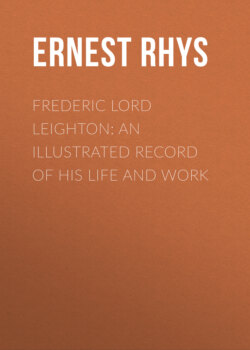Читать книгу Frederic Lord Leighton: An Illustrated Record of His Life and Work - Ernest Rhys - Страница 10
На сайте Литреса книга снята с продажи.
Year by Year—1870 to 1878
ОглавлениеSundry journeys into the East during this period of Leighton's career, gave him new subject-matter, new tints to his palette, and added something of an oriental fantasy to the classic sentiment of his art. The sketches of Damascus and other time-honoured eastern cities, mosques, gardens, and courtyards, which figured largely among Sir Frederic's studies, were made for the most part in the autumn of 1873.
Previously, as early as 1867, the East had cast its spell upon him. In 1868, he went into Egypt, and made a voyage up the Nile with M. de Lesseps, then at the flood of good-fortune. The Khedive himself provided the steamer for this adventure. "It was during this voyage," we are told, "that Sir Frederic came across a small child with the strangest and most limited idea of full dress that probably ever occurred to mortal—a tiny coin strung on to one of her strong coarse hairs." Of the studies made during the journey, one is a woman's head, draped so as to have a singularly archaic and Sphinx-like effect, Another is the fine profile of a young peasant; and yet another, the head of an old man, simple-minded and philosophical.
GARDEN AT GENERALIFE, GRANADA
MIMBAR OF THE GREAT MOSQUE AT DAMASCUS
(Since destroyed by fire)
In 1869 the Helios and Rhodos, already mentioned, served as the first sign to the public of the new R.A.'s interest in things oriental. To the 1870 exhibition, his only contribution was the picture, A Nile Woman, which is now owned by the Princess of Wales. It is a small full-length figure of a girl, balancing an empty pitcher upon her head, at the time of moonrise. Anticipating the Eastern subjects which future years produced, we may note a picture of Old Damascus, showing the Jews' quarter in that fabled city, in all its motley picturesqueness, and the delightful Moorish Garden,—A Dream of Granada, which were exhibited in 1874. A powerful picture, shown in 1875, of the Egyptian Slinger,[4] is illustrated later in this volume, but no reproduction can quite suggest the striking colouring of the original, and the masterly treatment of its light and shade, in the presentment of this lonely figure posed high on its platform against the clear evening sky. The delightful Little Fatima, and the Grand Mosque, Damascus, enlarged from the sketch previously alluded to, were also exhibited in 1875.
But perhaps the most picturesque memorial of the East due to the artist's wanderings of these years, is an architectural, and not a pictorial one. The fame of the Arab Hall in Lord Leighton's house has reached even further than that of Little Fatima, or his painting of the Grand Mosque at Damascus. Built originally to provide a setting for some exquisite blue tiles, brought by the owner from Damascus itself, it remains the most perfect representation of an oriental interior to be found in London; but this again belongs to a later period, and we must return to the date whence this chronicle was interrupted. Before doing so, however, it may be noted that in 1870 began the famous Winter Exhibitions of Old Masters and Deceased British Artists, of which Leighton was one of the most active supporters.
In the May exhibition of the Royal Academy, 1871, was hung a notable canvas, Greek Girls picking up Pebbles by the Sea, described at the time as "a delightful composition, comprising figures of almost exhaustless grace, and wealth of beauty in design and colour."
Another painting, also shown there, Cleoboulos instructing his daughter Cleobouline, is a charming example of its kind. The philosopher, with a scroll on his lap, sits on a cushioned bench with his young daughter by his side, his earnest action in delightful contrast with her girlish grace.
But his great work in 1871 was Hercules wrestling with Death for the body of Alcestis. The scene of this profound tragedy is on the sea-shore, where the body of Alcestis, robed in white, lies under the branches of trees in the centre of the picture. On the left is a group of mourners, a seated girl and a woman prostrate in grief. On the right are the two struggling figures; Hercules' superb form and tossing lion-skin contrasting finely, both in action and colouring, with the tall and coldly grey-robed spectre of Death, who presses forward to the bed where Alcestis lies, whence he is thrust back by the mighty Hercules. The exquisite figure of Alcestis with her statuesquely draped robes and their pure and delicate colouring, forms a wonderful contrast to the two strenuous figures on the right, while the figures of the mourners on the left are delightfully posed and full of grace.
In July of this year, it is interesting to remember, appeared Browning's "Balaustion's Adventure," which contained the following tribute to the above picture and its painter:
